Overview of armored transporters and infantry fighting vehicles (Part of 2)
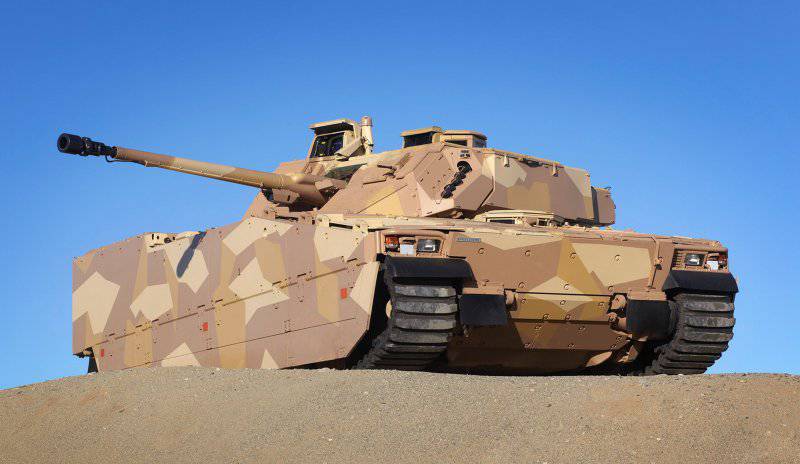
In the newest versions, only the name of the original machine - CV90; new BMP technologically gone far ahead of the machines entered service in the 90-s
European tracks for European contracts
Two European countries, Denmark and Poland, are going to replace a significant part of their fleet of armored vehicles. The first wants to replace their M113 armored personnel carriers. The Danish defense procurement organization FMT (Forsvarets Materieltjeneste) has already compiled a list of bidders, leaving it with tracked and wheeled solutions. The volume of the order can be from 206 to 450 cars in six versions. In turn, Poland wants to replace along with tanks T-72 and P-91 are Russian-made BMPs. The requirements define a universal tracked platform Universal Tracked Platform (UTP) with an expected combat weight of over 25 tons, which will serve as a base for approximately 1000 infantry fighting vehicles and 500 light tanks.
The Danish list includes three tracked solutions: Armadillo from BAE Systems, G5 Protected Mission Module Carrier (PMMC) from German FFG Flensburger and Ascod 2 from General Dynamics European Land Systems. As for the schedules for the implementation of these programs, the Polish project will go somewhat later than the Danish one, but it clearly defines that the production will be conducted at the plant of the local company Polish Defense Holding (formerly Bumar Group) and the first deliveries will begin no later than 2018 of the year. The decision on national development does not seem to be quite viable, and therefore Polish machines, created with the support of foreign partners and mostly based on already existing products, seem to be the more likely solution. Completion of the program is scheduled for 2022 year.
As already mentioned in the series “Protection of armored vehicles” (http://topwar.ru/40619-zaschita-bronirovannyh-mashin-chast-1-dlya-vadima-budet-pyat-chastey.html), CV90 is basically a new car compared to the original model, supplied by the Swedish army 20 years ago. Over 1200 machines are currently in service with five countries: Denmark, Finland, the Netherlands, Norway and Switzerland. Together with Sweden, they are part of the so-called System Development Council (in other words, the “CV90 Users' Club”), which collects the experience of operating this machine from the troops.
Improvements in mobility include semi-active suspension, which guarantees significantly better stabilization of the platform (reduction of acceleration in the longitudinal plane on 30 - 40%) and rubber tracks. The first increases the accuracy of weapons to the level of the MBT, and the second reduces the acoustic signature, and thereby limits the effectiveness of acoustic seismic sensors. In Afghanistan, these tracks produced by Soucy, a Canadian company, not only reduced the noise of cars by 10 dB, but their use also had a positive effect on fuel consumption and the safety of local roads, an important factor during stabilization measures. In addition, the newest machines surpassed the Bradley BMP in shallow snow thanks to a raised drive wheel and a better track angle, as well as in overcoming steps higher than 1,2 meters. The engine on the CV90 is installed the same as on Scania trucks, only in the military version. Its power increased from 370 kW in early prototypes to 600 kW in the newest version of the MkIII. Combat weight increased from 20 to more than 35 tons, mainly due to the constant increase in the level of armor protection, for example, new versions have a level of mine protection much higher than Stanag 4A / B. The increased power and suspension upgrades allow the 90-mm smoothbore gun to be mounted on the CV120.
Based on the requirements of Switzerland, the newest versions of the CV90 are fully digital. In this case, training time for service personnel is reduced from 15 to 5 months, and these requirements also contributed to the installation of digital systems for monitoring the condition and use of systems. Electronic architecture is also one of the major improvements in the newest version of the CV90. It simplifies the integration of new sensors, local situational awareness systems, reactive armor, and on-board simulation systems, which allows not only increasing crew productivity at the deployment stage, but also reducing crew response times.
Further upgrades are also proposed, for example, installation of a hybrid electric power plant from BAE Systems, which promises a reduction in fuel consumption by 25-30%; this figure may increase to 45% when driving on rubber tracks.
CV90 developed not only in the MkIII, but ultimately in Armadillo, a variant without a tower with a large internal volume and a carrying capacity of six tons, designed to perform various tasks, such as an armored personnel carrier.
Continuous modernization of the CV90 gave its results: after 18 years of production, two Swedish plants where the machine was manufactured continue to work. The recent lull in production was used by BAE Systems to optimize its production scheme: combining the entire production at the Örnsköldsvik plant and simultaneously modernizing it in order to increase production. This plant currently produces all tracked vehicles, including the CV90, which again began to roll off the assembly line after signing a contract in 2012 with Norway for the sum of 590 million euros. It includes upgrading the current fleet of 103 machines, and buying another 41 new car and a few additional chassis. The Norwegian army should receive 74 BMP, 21 reconnaissance, 15 commander, 16 engineering, two driver training and 16 multi-purpose vehicles, the latter for various tasks, such as a mortar installation or logistics. New machines will include most of the improvements in the areas of protection, survivability, situational awareness, information gathering and interaction developed at this time. Production will be conducted in Sweden, and in Norway an industrial group led by Kongsberg is responsible for assembly and integration.
In the future, more markets may open up for the Swedish car. In addition to Armadillo, chosen by Denmark, CV90-based solutions also “try on” the Canadian program for the Close Combat Vehicle (CCV) melee machine, which includes 108 machines plus an option for 30 units. This program was approved after attempts by some military circles to close it. The CV90 was also tested for the US GCV ground combat program.
At the end of May 2013, BAE Systems Hägglunds announced an agreement with Polish Defense Holding (PDH) targeting the Polish UTP program and in September at the MSPO in Kielce, the two companies showed the concept of the PL-01 direct fire support machine. It mainly uses the CV90 experience, and it will become the first member of the UTP-based family.
Tracked platform, which can be equipped with rubberized or fully rubber tracks, has a compact powerful engine, which occupies a relatively small volume in the hull, accommodating three crew members. The hull is protected from mines and roadside bombs, the armor is based on a multi-layer composite material of ceramics-aramid fibers, while the active protection complex enhances the survivability of the crew in combination with other passive solutions, such as new energy-absorbing seats. There is an uninhabited turret installed on the PL-01, which can be armed with an 105 or 120-mm cannon, both of which can fire with standard ammunition or anti-tank guided missiles. A lighter remote-controlled combat module at the top of the turret will be armed with an 7,62-mm or 12,7-mm machine gun or 40-mm automatic grenade launcher; The twin 7,62-mm machine gun complements the weapon system. The number of crew members is determined by the presence of the automatic loader installed in the turret tournaments.
Modern optoelectronics provides an overview and situational awareness; the commander has a panoramic sight to perform search and percussion tasks. Navigation and the "friend or foe" system will also be included in the set of the vetroniki. The modular design will allow the car of direct fire support to adapt for the most different tasks. The first prototype, manufactured by PDH in Gliwice, should be made by 2016 year. First deliveries are expected in the 2018 year, and their completion by the 2022 year.
The second tracked challenger for the Danish program is the Protected Mission Module Carrier G5 (PMMC G5) armored personnel carrier developed by the German company Flensburger Fahrzeugbau Gesellschaft (FFG), which has extensive experience in the development and modernization of military tracked vehicles, including M113 and Polish Opal. The weight of the machine is 26,5 tons with further growth potential, G5 has six track rollers and a front guide wheel. Engine power 560 HP The MTU 6V199 TE21 is mounted in front on the right, the driver is sitting on the left with access to the aft landing. Thus, he can take his seat either through the upper hatch or through the troop compartment. To ensure a good view, it has a raised flashlight with 180 ° windows, which provide a good forward and left view and a slightly worse view to the right. Armored windows are protected by steel bars. This allows the driver to remain protected while maintaining a driving position similar to the driving position of an M-113 BTR with his head stuck out of the hatch.
Also in front of the installed day / night camera. The engine is connected to an automatic transmission ZF LSG 1000, which rotates rubber tracks from the company Soucy. The G5 BTR has a very large internal volume 14,5 m3, its payload is 6,5 tons. It can carry up to 12 people, four paratroopers from each side sit facing each other in energy absorbing seats. The driver, the commander of the vehicle and the commander of the assault force are sitting in front, they have displays of the combat control system, also showing the image from the camera, and eventually from other sensors (when installing the combat module on the roof).
As already mentioned, the PMMC G5 was designed on the basis of a modular concept. The base of the car is made up of a standard mini-chassis, power unit, transmission, suspension, air conditioning and heating, driver and commander and interfaces. Various functional modules attached to the bottom of the chassis can be installed on the machine to meet various tasks performed, for example, the personnel conveyor, command post, sanitary, medical evacuation, cargo, although mortar installations, patrol and other options were also considered. Replacing the module takes several hours. This allows you to minimize the amount of logistics. The modules are transported and stored inside standard ISO containers, which reduces the cost and simplifies their transport processing. According to FFG, the PMMC G5 armored personnel carrier was designed to minimize life cycle costs. FFG manufactured three G5 prototypes, which are optimized variants of the first prototype and which today have hit a total of about 20000 km. The G5 BTR is currently undergoing field trials in Denmark, and according to the FFG, contracts have been concluded with various interested parties from several countries. In 2011, the FFG and Krauss-Maffei Wegmann companies announced an agreement to modernize the BTR fleet of Brazil's M113.
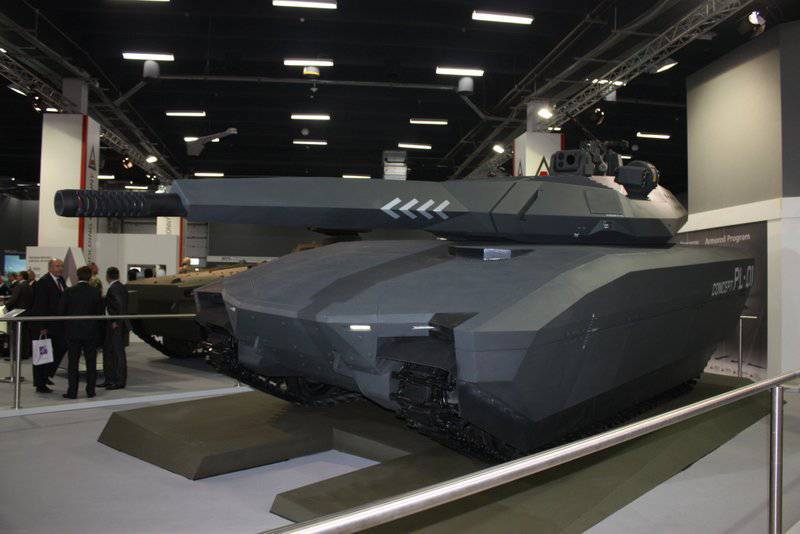
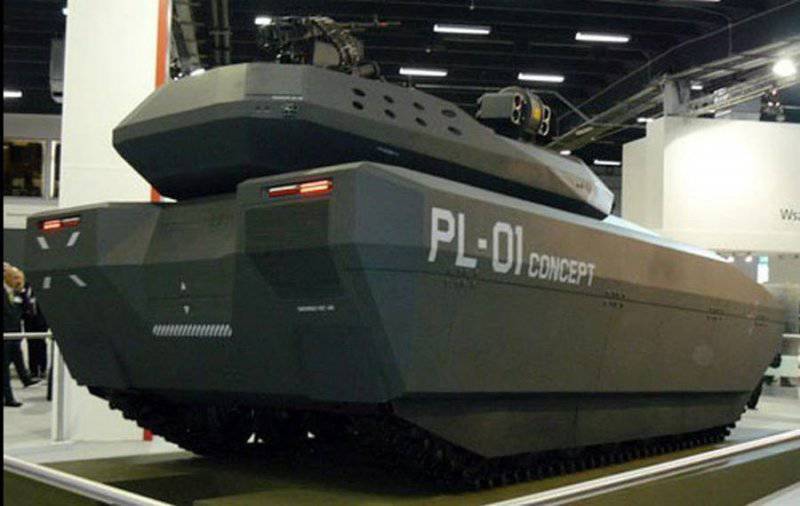
At the Polish MSPO 2013, Poland, BAE Systems and Polish Defense Holding showed the concept of a PL-01 fire support vehicle based on the universal UTP tracked platform
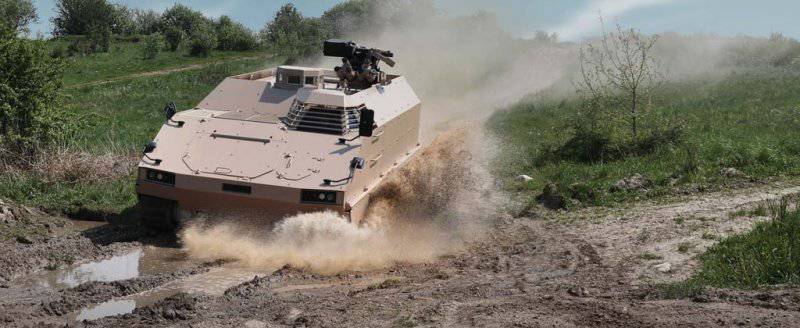
Protected Mission Module Carrier G5, developed by FFG Flensburger, is one of five vehicles selected by Denmark for the M113 BTR replacement program.
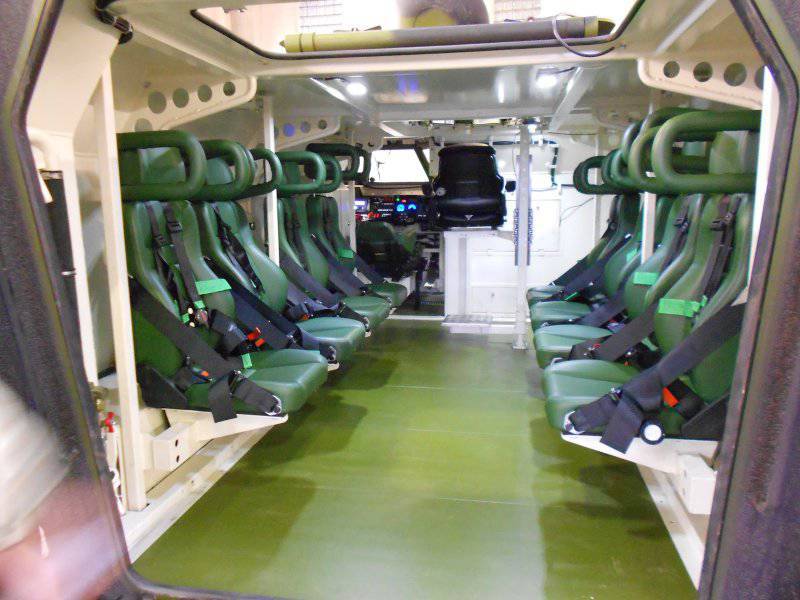
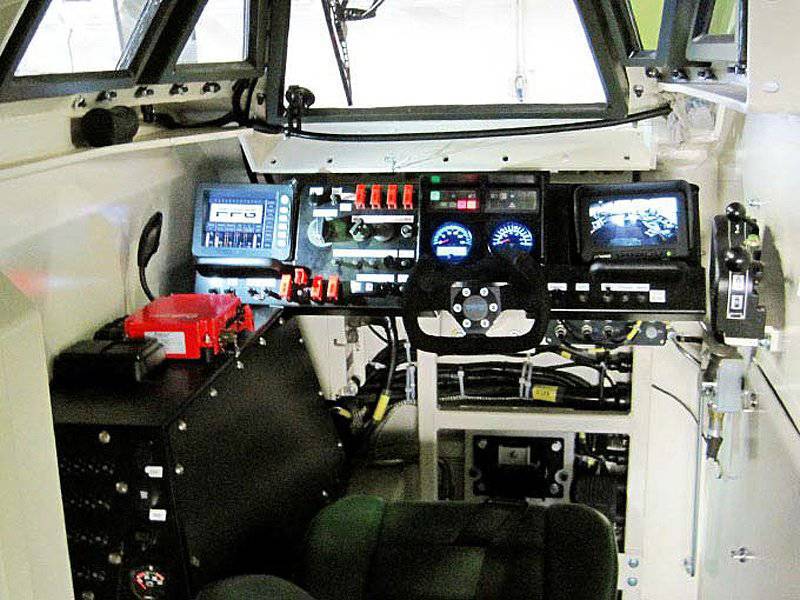
Below is a view of the PMMC driver's seat from the inside. It features a wide windshield that provides good situational awareness. Top view of the separation of troops
ASCOD program
General Dynamics UK in March 2010 was selected as the preferred applicant. Her proposal for the program of the British army on the SV Scout car in July was awarded a contract for a demonstration stage, which included the manufacture of seven prototype Ascod tracked vehicles equipped with a Lockheed Martin turret with a CTAI 40-mm cannon. By the way, it should be noted that the tower itself is based on the Lance tower from the company Rheinmetall.
The final step was the completion of the testing of the mobile test system at low temperatures, which followed the testing of the cooling system under full load at extreme temperatures. Thus, the performance of the systems was tested in the operating temperature range 80 ° C. The tests were conducted in a cold climate chamber in Spain. The mobile test facility has passed a series of severe tests, including running tests over 10000 km. A critical evaluation of the project is expected to be completed at the end of 2013, while production decisions can be made in 2014-15.
The Ascod 2 was also selected as one of the contenders to replace the M113 armored personnel carrier in the Danish army.
A brief video review of the project status on the family of armored combat vehicles ASCOD
Puma BMP is close to supply
Over 350 BMPs Puma were ordered by Germany from Projeckt System & Management (PSM), a joint venture between Krauss-Maffei Wegmann and Rheinmetall Landsysteme specially created for this project. Nine machines have been manufactured and are currently undergoing extensive qualification tests.
The Bundeswehr originally ordered Puma's 405 vehicles, but after the reorganization process, the German military and PSM agreed in July to reduce the order to 2012 vehicles (350 BMP and 342 driving instruction machines) and extend the qualification testing period to the end of September 8.
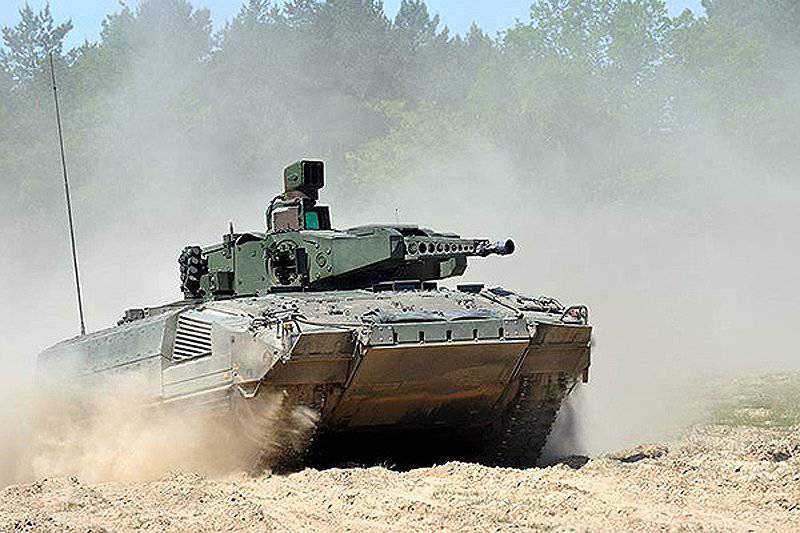
The German Puma BMP, developed by the joint venture KMW and Rheinmetall, by PSM, has undergone some refinement and is currently close to production
Compared to early prototypes, the production cars have a new undercarriage with six track rollers instead of five. Also, the first Puma cars had a greater distance between the third and fourth and between the fourth and fifth rinks, whereas now the distance between all the rinks is the same, which increases stability and improves driving performance on rough terrain. Additional space was also found in the onboard chassis modules in order to increase the fuel volume from 800 to 900 liters. Another major change can be seen on an uninhabited turret, which is currently characterized by a pyramidal vented gun cover, which ends near the muzzle. According to PSM, this further improves the accuracy of the fully stabilized 30-mm MK30-2 / ABM automatic cannon. The machine is equipped with the Muss active protection complex, its launchers are now made rotating. Four IR / laser sensors mounted around the tower perimeter provide 360 ° circular coverage; The data is transmitted to the central electronic system, which ensures optimal orientation of the infrared silencer and launcher before launch, ensuring maximum protection against the attacking missile. For the German army, a launcher with two anti-tank missiles will be installed, and the integration of the Spike-LR missile system is currently being developed.
BMP Puma has already passed an advanced qualification and verification program. Numerous individual tests and tests were carried out and completed: running, operational, ergonomic, and the functionality of the SLA, turret systems, and weapons was tested. Also at the beginning of 2012, the Arctic Circle in Norway in parallel passed successful three-month low-temperature tests. In addition, by the end of 2013, comprehensive qualification testing of the systems will take place, with numerous activities planned.
As for the logistical qualification tests, starting from May 2013 of the year, the German military from the Land Systems Technical School perform tests for the maintenance and repair of the Puma BMP. They cover the verification of the main elements of the curriculum, including a comprehensive theoretical and practical understanding of the maintenance process, testing of special tools as described in the interactive electronic technical documentation, as well as carrying out practical maintenance of the 2 and 3 levels.
Tactical qualification trials began in May 2013 of the year and ended in the middle of August 2013 of the year. The tests were carried out in the Armored School of the German Army in Münster on one machine, as well as at the platoon level of four cars. They included operations with dismounted or motorized infantry, combat maneuvering, shooting at large angles of vertical guidance in urban environments, platoon level exercises and general military exercises in conjunction with the main battle tanks. By the time these lines are read, the Puma BMP should complete two or three-month trials in the hot climate of the United Arab Emirates.
Immediately after receiving a user certificate based on the results of all tests carried out, in 2014, the production of Puma machines will increase to about 50 units per year and will continue until the final delivery in 2020. The transfer of the first BMP Puma of the German army is scheduled for 2014 year. Puma is also moving to overseas markets, for PSM Canada and Australia are currently priority areas.
Warrior & Co
In the UK, Lockheed Martin continues to work on the Warrior WCSP (Warrior Capability Sustainment Program) BMP life extension program. In November 2012, a new mobile test set was manufactured to test the stabilization of the turret, servo drives of the turret, evaluation of ergonomic characteristics, training and testing of general parameters. It can hold up to 8 tons of ballast to simulate typical dynamic loading conditions. Lockheed Martin UK’s WCSP offerings are based on the refinement of the Warrior turret, which received the CTAI 40 gun. Also in the modernization kit includes improvements in mobility, protection and control systems. In 2013, the project capabilities were successfully evaluated, and in 2014, a critical evaluation of the project is expected, which will complete the demonstration phase. Production should begin in 2016 with the first deliveries to the troops in 2018.
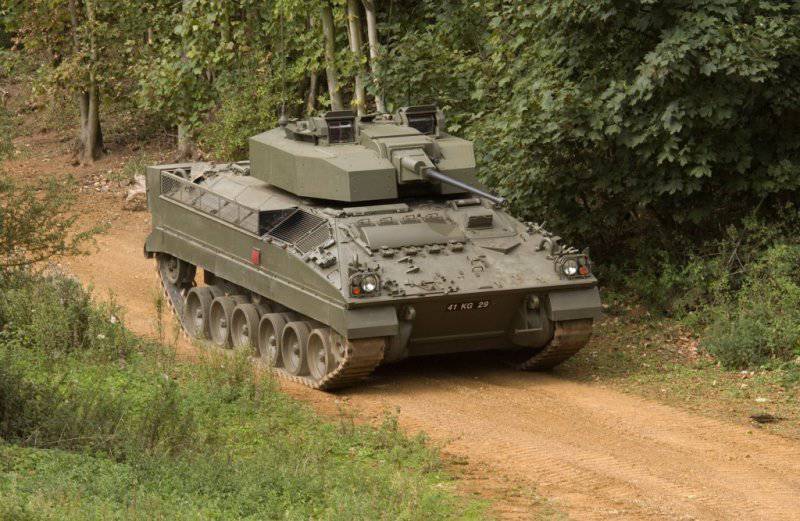
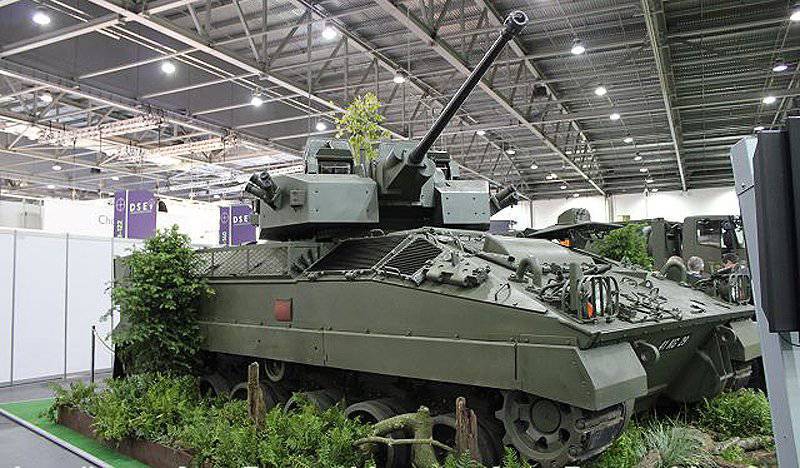
Lockheed Martin UK is set to begin production on the BMI Warrior life extension program in 2016; A critical project evaluation is scheduled for 2014 year.
Meanwhile, Lockheed Martin UK is also awaiting the selection of a contractor for the Kuwaiti Desert Warrior Machines Modernization Program, which was to occur at the end of 2013. Although other turrets and a cannon can be selected for these machines (it is quite possible that the 25-mm M242 ATK with double feed will be selected), Lockheed Martin UK will have an advantage over its rivals - a team of Raytheon Network Centric Systems, BAE Systems and General Dynamics Canada - thanks to the experience gained through the WCSP program.
Overview of the program for extending the life of the BMP Warrior with Russian subtitles
New player
The Republic of Georgia was the last country to join the club of tracked vehicle manufacturers. At the end of February 2012, she showed her BTR with a combat module. The machine, named Lazika, is armed with an 23-mm 2A14 cannon and a 7,62-mm machine gun, its combat weight is 14 tons. Frontal and side protection - 4 Level, from the stern - 2 Level. An additional reservation is available, increasing the level of protection to 5, while the level of mine protection is 4a / b. The car housed three crew members and up to seven infantrymen, parachuting through the stern ramp. The machine was created by the military-scientific technical center Delta, and is manufactured by the Tbilisi company Aircraft Manufacturing. Engine power 300 HP it is mounted ahead on the right and allows the Lazika BTR to develop a maximum speed of 70 km / h, and a torsion bar provides a large stroke of the five support rollers.
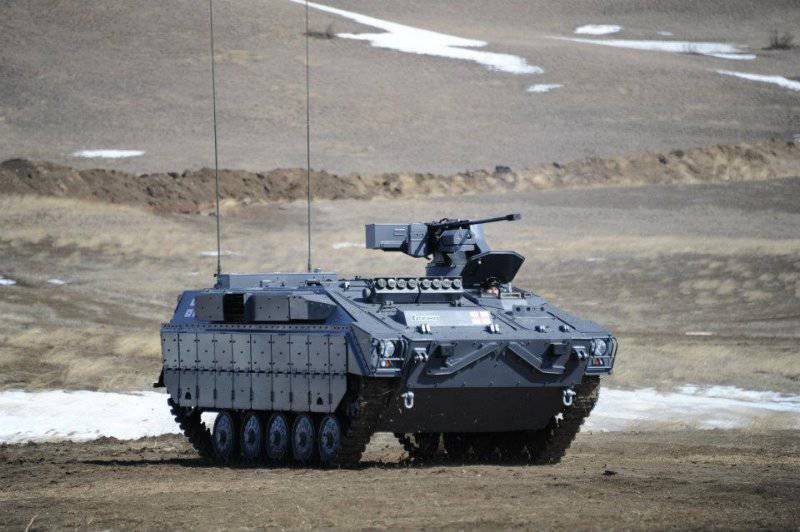
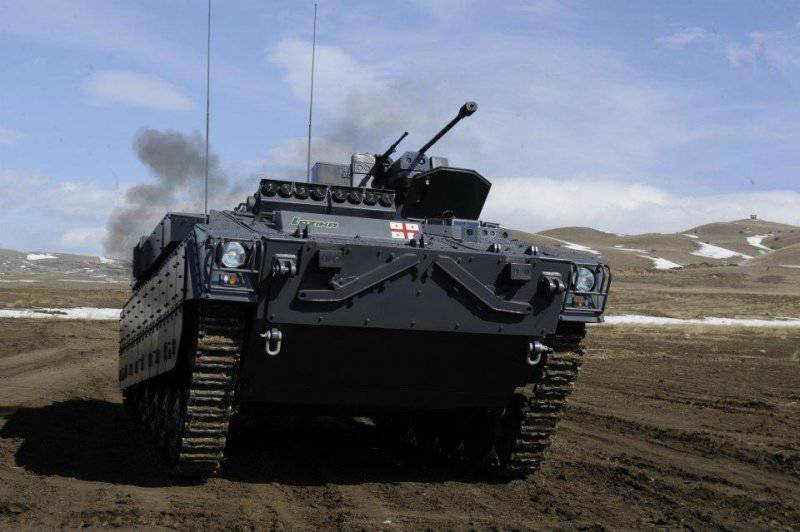
Georgia has become one of the last countries to enter the armored vehicles market. The Lazika armored personnel carrier weighing 14 tons can carry up to seven paratroopers and three crew members
Armor on wheels
The AMPV program of the US Army is quite possible to stop on the tracked variant, while the market for tracked vehicles in the coming years will be much more focused on the United States compared to the market for wheeled infantry fighting vehicles and armored personnel carriers. The main program for the development and acquisition of the wheeled vehicle in the coming years will be the MPC (Marines Personnel Carrier) armored personnel carrier for the US Marine Corps.
In the framework of the Canadian program for a close combat vehicle (Close Combat Vehicle), the number of applicants was reduced to Nexter VBCI with the 25 mm tower and GDLS Piranha 5.
Interestingly, Denmark is considering these same cars for the “wheel option” under the M113 fleet replacement program (see above). But the largest program in Europe is the Spanish Army program, which plans to transform its eight brigades into multitasking brigades (Brigada Polivalente) based on the 8 × 8 platform in several versions: combat, reconnaissance and command, followed by a mortar, anti-tank, evacuation sanitary and engineering options. However, the current financial situation in the country has strongly postponed for the distant future all these plans for modernization, the replacement of existing weapons has been postponed to 2020 - 2040 years.
In Turkey, the requirements for the 6 × 6 machine have been voiced, although the configuration of the 8 × 8 seems to be still far away. In the Middle East, the UAE has a need for some 700 8 × 8 machines, and neighboring countries are also interested in such platforms. In the Far East and Latin America, they also look at wheeled infantry fighting vehicles and armored personnel carriers.
Brazil is also considering 8 × 8, armed with an 105-mm cannon, as a replacement for the EE-9 Cascavel and Sk105 light tank, a request for information was sent to the manufacturers of the towers. Four companies responded to this request, Oto Melara with Hitfact 105, the Brazilian Ares Aerospacial e Defesa division of Elbit Systems with its MT 105BR, CMI Defense with the CT-CV 105HP tower and Tarobá Engenharia with an unnamed offer. The request for proposals was to be published at the end of 2013, when it was expected to sign a contract between the Brazilian army and Iveco Latin America to create a version of the Guarani 6 × 6 machine in the 8 × 8 configuration.
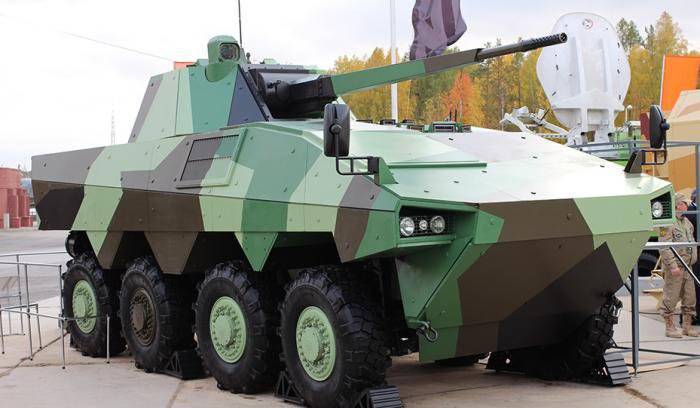
At the exhibition Russian Expo Arms Uralvagonzavod and Renault Trucks Defense announced a new BTR Atom 8x8, intended for the Russian market
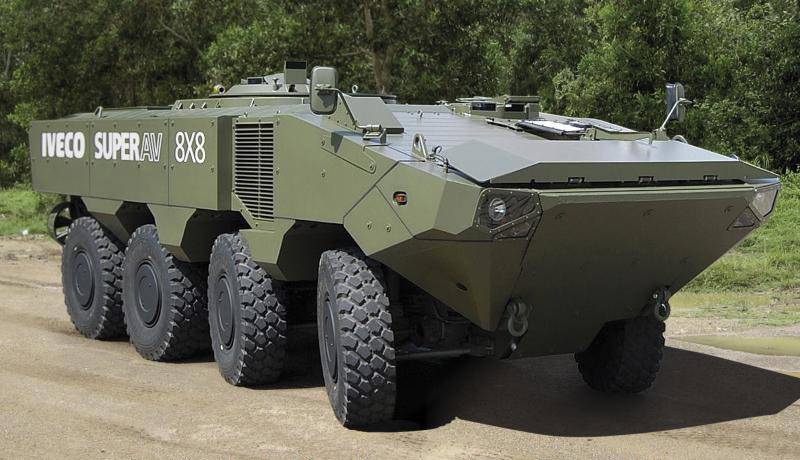
BAE Systems has teamed up with Iveco DV to respond to the demands of the new BTR for the Marine Personnel Marine Carrier; The car in the photo is an option Iveco SuperAV
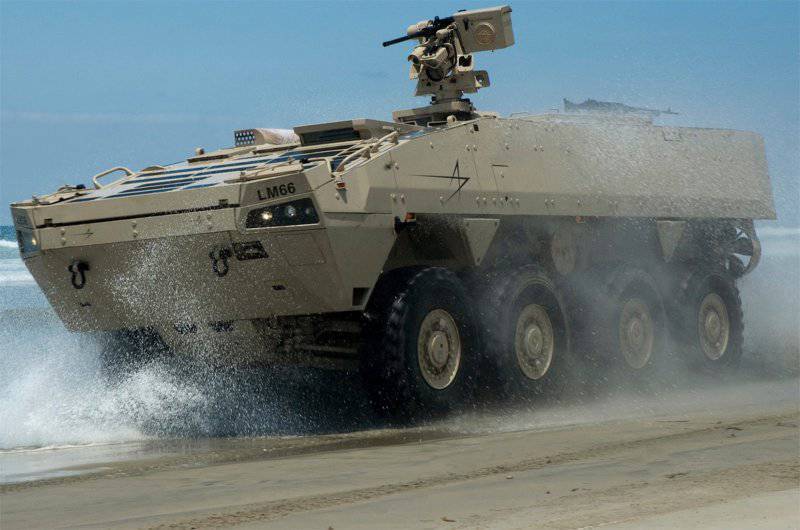
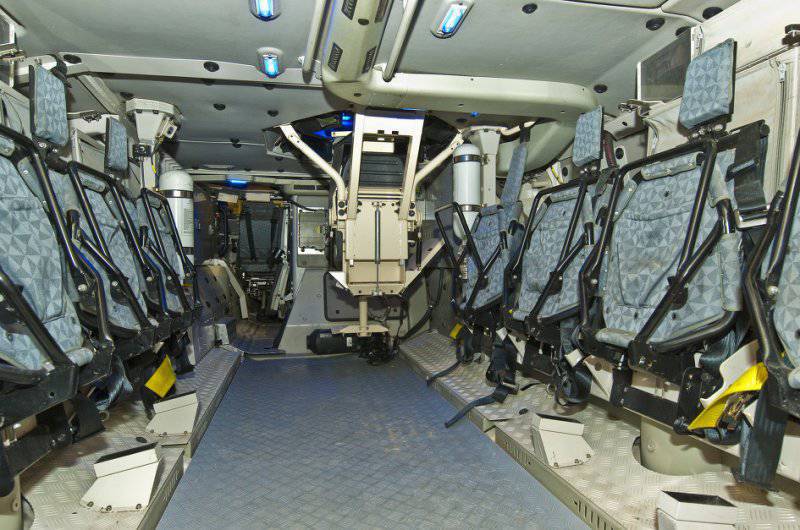
Under the Marines Personnel Carrier program, Lockheed Martin merged with the Finnish Patria and offered the option of an armored modular armored vehicle. Troop compartment (bottom)
Marine Personnel Carrier Program
In the light of budget cuts in the US, the fate of the MPC program is still not entirely clear. The commander of the US Marine Corps, General James Amos, clearly identified the Amphibious Combat Vehicle combat vehicle of the highest priority for the corps. Thus, Marine Personnel Carrier could become a “nice to have” type machine. In September, 2013, the amphibious, ballistic and explosive tests ended and the companies participating in the competition expect a detailed report on them in November. What happens next remains a mystery. Will MPC replace the ACV project if there is too much time shift? Will it be a backup solution if the ACV project fails?
Will the ACV be successful in the military in case of sufficient funding? After all, there were rumors about a possible series of sea trials in 2014, followed by a request for prices at the beginning of 2015, and the issuance of a contract to two applicants for final development and implementation in production.
Two of the four proposals are widely publicized, namely Havoc (based on AMV from Lockheed Martin and Patria, also Armatec Survivability Corporation participates here) and SuperAV from the BAE Systems team - Iveco DV. Two other projects are less open to the public: ST Kinetics' Terrex 8 × 8 seems quite standard machine adopted by Singapore. As for the proposal of GDLS, here, against the background of the lack of official information, the Youtube resource has published a video of what the modified Piranha 3C looks like with 12-inch wheels and increased height (to obtain sufficient buoyancy).
Materials used:
Armada Compendium to 5 / 2013
www.ffg-flensburg.de
www.generaldynamics.uk.com
www.lockheedmartin.com
Information